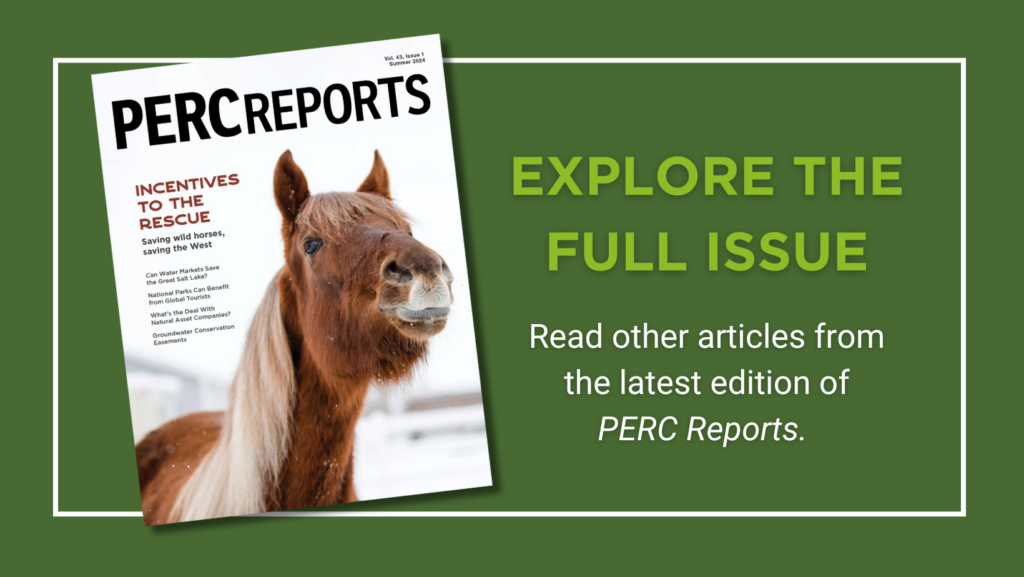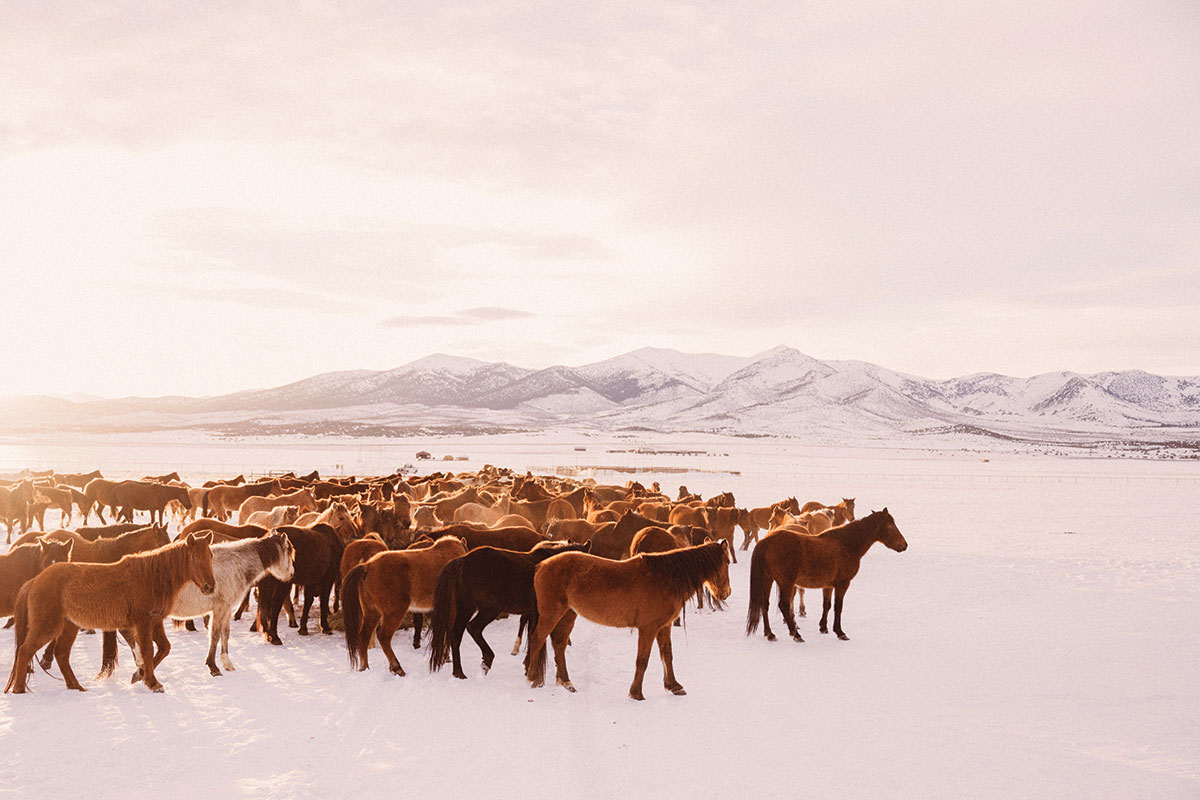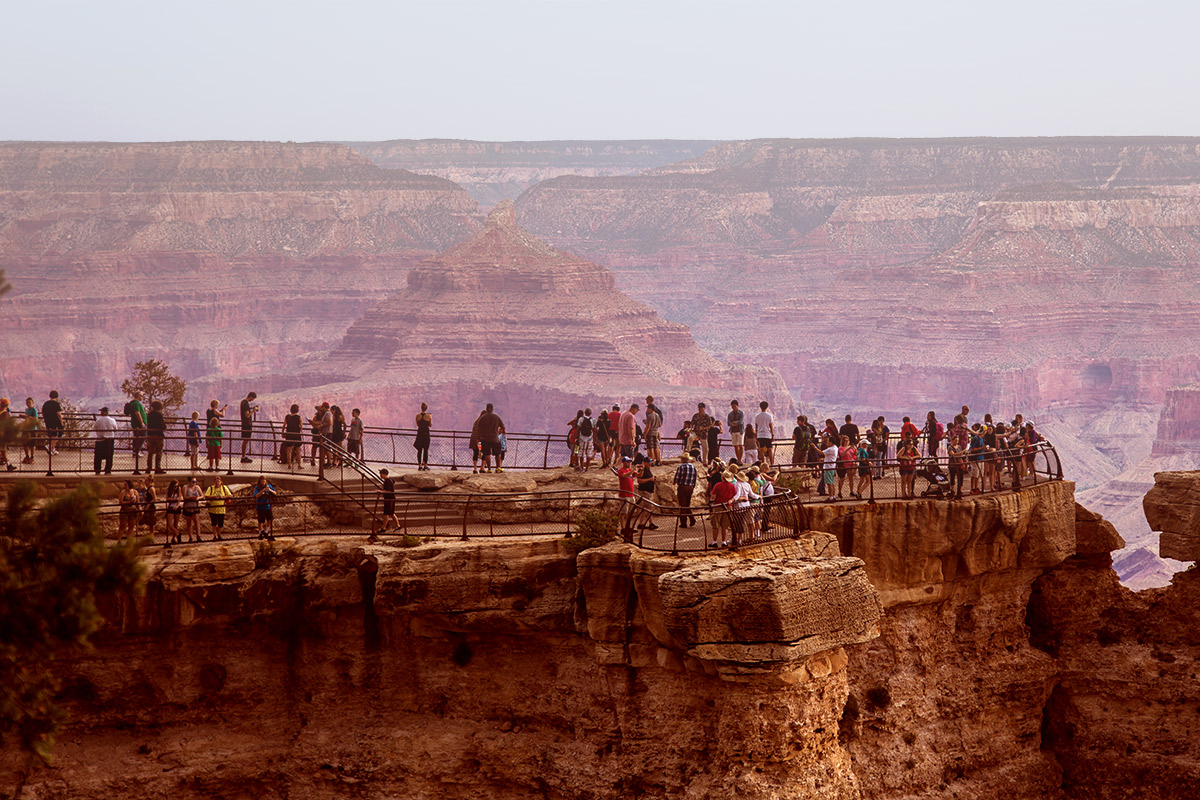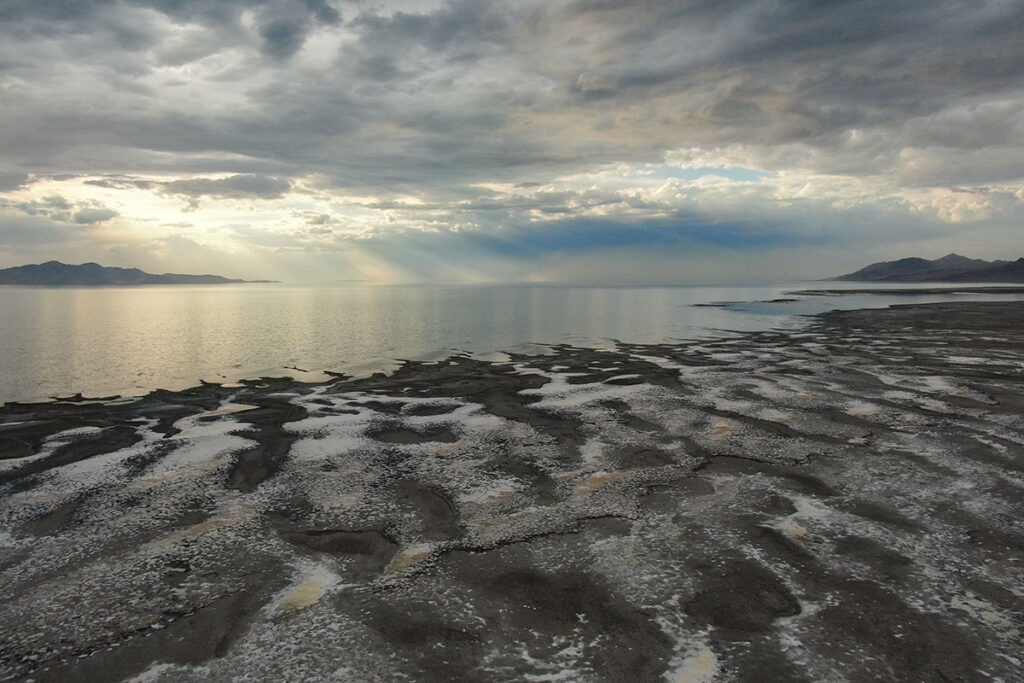
When the sculptor Robert Smithson began laying down rocks at a place called Rozel Point, a nub of shoreline encircling the Great Salt Lake, he had no idea that one day his twisting, turning creation called Spiral Jetty would become a touchstone for thinking about an epic crisis.
The year was 1970, and the population of the lake’s namesake metropolitan area, Salt Lake City, was nearly half a million people. It wasn’t a long drive then for urban denizens to reach the pastoral countryside.
Today, the booming Salt Lake metro area, whose northern tentacles reach clear to Ogden, has a population of more than 1.2 million, representing a tripling since Smithson stepped into the saline waters of the Great Salt Lake. Along the entire Wasatch Front are 2.5 million residents. Some 85 percent of all Utahns live there. And where once Smithson’s acclaimed naturalistic art installation was slightly submerged, it’s now high and dry—a marker for pondering how much the lake’s water line has receded.
In recent years, the Great Salt Lake—the largest saline lake in the Western Hemisphere—has been anything but great. Now in triage, its surface area has been in profound retreat. In 2022, it fell to a record low, a level not seen since measurements were first taken in 1847. Without intervention to stave off further retreat, Brigham Young University analysts who track lake levels have predicted it could dry up in 2028.
The current problem stems not from removing water from the lake but from diminishing supply flowing in, and that has set off a domino effect of issues related to ecology, economy, and human health.
As part of an unprecedented effort to save the lake, state officials have rapidly assembled a diverse brain trust of experts. Among the entities they’ve enlisted is PERC, because of its proven track record of thinking about complicated natural resource challenges and successfully applying market-based approaches to resolve them.
Some 27 million air travelers will pass through Salt Lake City International Airport this year, flying over the Great Salt Lake as they arrive or depart. What many passengers may not realize is the shimmering expanse below them is also a critical stopover and breeding ground for more than 10 million birds, making it what some ecologists consider the largest wetland complex in the intermountain West.
In addition to potentially losing the lake, some scientists say there could be an even larger disaster looming if toxic minerals left behind on an expanding dry lakebed become airborne in wind events, threatening the health of human residents. Over the past two years, anxiety has turned to alarm. The fact that Salt Lake City is all but confirmed to host the Winter Olympics in 2034 has brought additional scrutiny to the problem. Utah has now created an Office of the Great Salt Lake Commissioner to oversee a massive evaluation of natural water supply and demand throughout the hydrological systems feeding the lake. Earlier this year, the commission released its Great Salt Lake Strategic Plan, and it doesn’t mince words, identifying a three-step course of action to reach a long-term solution.

To show how serious the issue is, the state legislature has also passed a series of reforms that figure prominently in its short and mid-term strategy. These include addendums to age-old “use it or lose it” laws that permit farmers to conserve water without losing rights to it, investing in agricultural water optimization projects, allowing users to lease their water savings to boost environmental flows, and giving farmers greater flexibility to lease portions of their water rights during dry and wet seasons. On top of this, the state is promoting innovative measures to maintain instream flows by creating water trusts and a series of water banks. Still, the measures are new, and uptake among farmers has been slow.
A Wicked Problem
Dr. Katherine Wright, a PERC senior researcher who specializes in western water, admits that trying to save the Great Salt Lake is an especially daunting challenge. “What we have in front of us fits the very definition of a wicked problem,” she says. A “wicked problem” is one that’s extremely difficult and often perceived as being impossible to solve because of incomplete, contradictory, and changing variables.
Indeed, that’s precisely the case with trying to address water scarcity here and elsewhere. Not only is water truly fluid and dynamic, but the way it cycles through the environment of the Salt Lake Valley and is redistributed by humans is enormously complicated. Add legal and historical complexity, competing demands, and incomplete data, and you have a wicked problem.
In the late 19th century, Mormon farmers, using their ingenuity as engineers, essentially created a network of modern aqueducts that drew water from the Great Salt Lake’s three major tributaries—the Bear, Jordan, and Weber rivers. They turned arid expanses of the eastern Great Basin into farmland through a carefully crafted irrigation system. Alfalfa was grown to feed cattle, fruit orchards and sugar beet fields proliferated and harvested every summer a bounty of fresh vegetables. On top of this system grew a thriving rural and urban economy that, metaphorically speaking, floated on water originating not only from melting mountain snowpack in the vaulting Wasatch Range and coursing through the rivers, but bolstered, too, by spring rains and aquifers.

Katherine Wright, Ph.D.
Senior Researcher
An expert on water policy, Dr. Wright believes applying market thinking can help untangle the knots involving supply and demand, regulatory approaches versus incentives, and the interconnections of economy and ecology.
Today, despite recent changes in water law, the administration of that water remains largely byzantine. The current problem, Wright notes, stems not from removing water from the lake but from diminishing supply flowing in, and that has set off a domino effect of issues related to ecology, economy, and human health.
In formal partnership with the state’s Great Salt Lake Commissioner’s Office, PERC is exploring how water rights and innovative trading mechanisms might be applied in ways that incentivize water conservation while respecting and upholding water rights as vital economic assets. Many of the reforms recently implemented by the state create enormous possibilities for broader use of water markets to bolster the lake’s level. “The ultimate goal, of course, is making sure that adequate amounts of freshwater reach the Great Salt Lake,” Wright says.
The same flows that would otherwise reach the lake have, over millennia, created a rich system of wetlands that provide vital habitat for wildlife, especially birds—between 10 and 12 million individuals comprising 338 different species. The Bear River Migratory Bird Refuge, rimming the northern shores of the Great Salt Lake, is not only a critical avian stopover site, but it also provides nesting grounds for 67 different species. The refuge is a famous homeland of colonies of white ibis numbering 10,000 strong. It’s also a popular destination for wildlife watchers, recreationists, artists, and, in the tributaries’ upper reaches, anglers—all of whom have expressed grave concerns about the lake’s demise.
Avoiding potential federal intervention from both wildlife and pollution control agencies has been a strong unifying motivation for private water users along the lake’s tributaries and more than 1,000 canal companies of varying sizes. There is fear that state agencies might order flows to reach the lake, but without proper compensation to agricultural operators and water companies.
Wright notes that although gravity pulls water in one direction, the course it takes in the Salt Lake Valley is labyrinthine and nonlinear, the result of an incalculable number of incremental decisions made across more than a century. Everywhere one looks, it seems there are more ripple effects related to the water issues. She believes applying market thinking can help untangle the knots involving supply and demand, regulatory approaches versus incentives, and the interconnections of economy and ecology. In partnering with the state, PERC is specifically helping develop a comprehensive model that identifies the best opportunities to conserve water and facilitates voluntary water leasing, with the aim of helping more upstream water reach the lake.

Confronting the Challenges
None of what lies ahead will be easy. There is recognition, though, Wright notes, that delaying hard choices could have costly repercussions. The Great Salt Lake Advisory Council stated that “the monetized potential costs of a drying Great Salt Lake could be as much as $1.69 billion to $2.17 billion per year and bring over 6,500 job losses. Over twenty years, these costs could be as high as $25.4 billion to $32.6 billion…” The Wasatch Front already suffers from an impaired airshed, but it could get far worse. As of 2023, over 800 square miles of lakebed were exposed to wind erosion and dust storms, potentially impacting 2.5 million residents along the front.
Increased dust storms could also harm tourism in the state. It negatively impacts snowpack, which is the foundation of Utah’s commercial and recreational ski industry and is itself tied to a multi-billion-dollar real estate industry in mountain towns. “Those estimates skyrocket if costs and affected surface area [of dry lakebed] increase,” the legislative report says. “Beyond these direct costs, ecological impacts become more difficult to quantify but may have far-reaching impacts if protected birds become adversely affected, which initiates a federal response.”
Meanwhile, the spotlight is shining on agriculture, which uses the majority of water being diverted from the lake’s tributaries, more than any other user group. Terry Camp, vice president of public policy with the Utah Farm Bureau, says it’s important that any attempt at addressing root causes not sow more chaos than the problem itself. Camp was previously a policy expert on the U.S. House Natural Resources Committee and is well versed in pondering wicked problems. He also understands the usefulness and limitations of solutions hatched by government bureaucracies compared to problem-solving aggressively embraced by the private sector. He agrees with Wright that markets, backed by the law, can streamline allocation of a valuable resource rather than complicate it or erect barriers.
At the end of the day, without exception, it’s all about incentives.
Camp says that during his time in D.C., he was impressed whenever PERC staffers came to the nation’s capital to testify on a variety of issues. And while in recent years those issues have included conserving world-renowned wildlife migration corridors in the Greater Yellowstone Ecosystem, addressing an overabundance of wild horses on public rangelands, and reforming the Endangered Species Act to make the law more effective at recovering wildlife, PERC’s research foundation was largely built on water issues. Since the 1980s, PERC researchers have been studying how water markets can bring 19th-century water law into the present day. It’s work that is especially relevant at a time when much of the arid West is dealing with chronic conflict.
Confronting the challenges facing the Great Salt Lake is now an organizational priority for PERC. Camp says public concern about the lake has created easy scapegoats. Some engaging in a blame game are pointing their fingers primarily at the agricultural community, claiming water shouldn’t be used to grow crops in the desert. In recent state legislative sessions, the Farm Bureau perhaps surprisingly lobbied on behalf of sweeping revisions enacted to state water law, including amendments to the “use it or lose it” doctrine that dates back to statehood. Farmers and ranchers embrace the changes because they ultimately give water rights holders greater flexibility and reduce the level of concern that if fields are rested or water is leased for conservation purposes, they aren’t in danger of losing their water rights, says Camp.
“At the end of the day, without exception, it’s all about incentives,” says Wright. “In this case of the Great Salt Lake, it’s about answering the question: How can we devise policies that recognize individual motivations and yet reward everyone coming together to achieve a common goal? Nobody wants the lake to go away.”
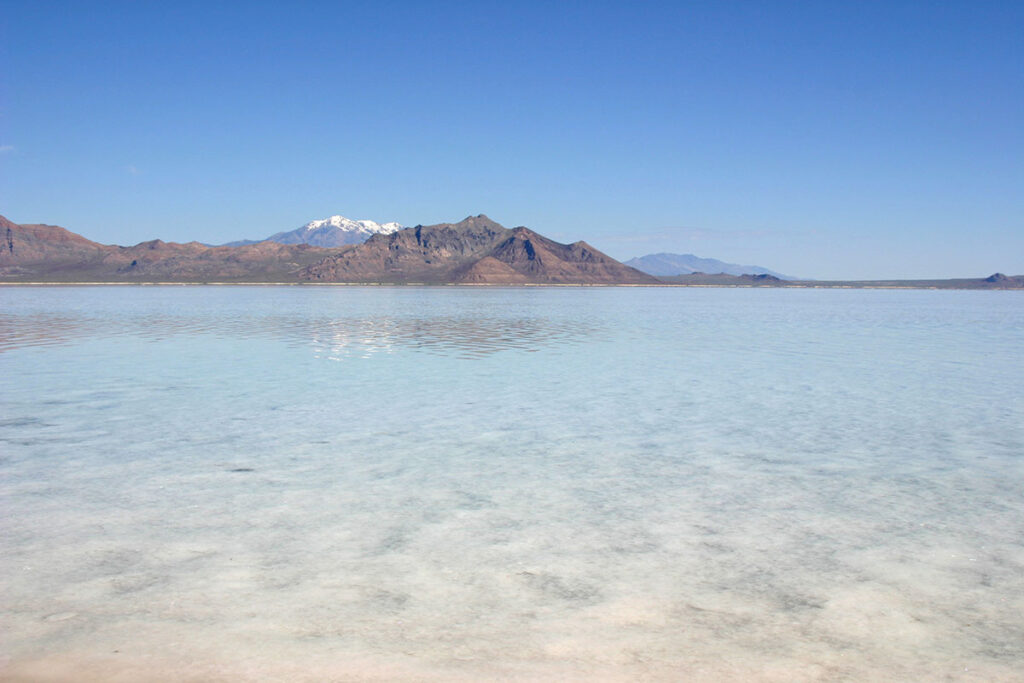
Healthy Horizons
Sometimes, a crisis can be a good thing. It can force a status quo that previously had no strong incentives to change to embrace innovation—and do it in a way that is fair and equitable. Markets can be great vehicles for helping to illuminate and distill what society values most. They are not there to socially engineer outcomes or pick winners and losers.
Tim Davis, the deputy Utah water commissioner, previously worked on water-related conservation in Montana, and he is lending the insights he gleaned there to address the ecological dimensions of the task. “We have limited resources. The reality is we need to use the tools we have to address the needs of the Great Salt Lake and get it back to a healthy water level range, then sustain it there,” Davis says. “Largely, we’re focused on carrots, not sticks.”
PERC is playing a critical role, he says, in helping to identify key water rights holders and figure out the economics of how water can be strategically marshaled. “We’ll be looking at leasing rights and potentially purchasing from willing sellers to secure more water so that it can be effectively delivered to the lake,” says Davis. “This will include cultivating relationships with senior rights holders who have the authority to call water down when we need it and others near enough to the lake who have the infrastructure in place to ensure it actually gets there. Having PERC helping us develop better tools is important.”
Wright adds that it would be optimal to have multiple stakeholders rally around a common cause—reviving the lake. The results could include more stable habitat for wildlife; more clarity, flexibility, and predictability for water rights holders; reliable instream flows that benefit trout in the tributaries; and a healthier brim of water that allows for lucrative lithium extraction to help transition to a better energy future and confront climate change.
Nobody involved is a Pollyanna, at least not anymore. The consequences of failure are unacceptable—to everyone. “Because this is a wicked problem,” Wright says, “we’re going to need solutions that are as dynamic as the challenges we are trying to overcome. This is an opportunity for everyone to re-envision new possibilities.”
One of those possibilities, albeit small, yet symbolic, will be to return to Rozel Point a generation in the future and see once again Robert Smithson’s famed art installation bathed in the same amniotic fluid of its origin. Because now, standing next to Spiral Jetty, not even an NFL quarterback could throw a Hail Mary far enough to reach the Great Salt Lake.
